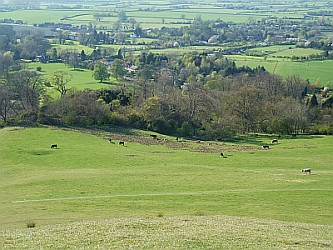Cymbeline's Castle facts for kids
Quick facts for kids Cymbeline's Castle |
|
|---|---|

Cymbeline's Castle and Little Kimble
|
|
| Highest point | |
| Geography | |
| Location | Great Kimble, Buckinghamshire |
| OS grid | SP 83265 06350 |
Cymbeline's Castle is the old ruin of a motte-and-bailey castle in the woods near Great Kimble, a village in Buckinghamshire, England. It's also known as Cymbeline's Mound or Belinus's Castle. This historic site is protected by a special law called the Ancient Monuments and Archaeological Areas Act 1979, which means it's important to keep it safe for the future.
Contents
What is Cymbeline's Castle?
Cymbeline's Castle was once a type of castle called a motte-and-bailey. This kind of castle was popular in England after the Normans arrived in 1066. It had two main parts:
- A motte was a big earth mound, usually with a wooden tower on top.
- A bailey was a courtyard area, often surrounded by a fence or wall.
The motte at Cymbeline's Castle is quite large, about 42 meters (or 138 feet) wide. It's surrounded on three sides by a deep ditch, which would have made it harder for enemies to attack. Outside this main ditch, there are two more bailey areas.
What Have We Found There?
Archaeologists, who are like history detectives, have found interesting clues at Cymbeline's Castle. They discovered pieces of pottery from the 13th to 15th centuries within the bailey areas. This tells us that people lived or used the castle during the Middle Ages.
Even older pottery fragments have been found to the east of the castle remains. These pieces date back to the British Iron Age and the Romano-British period. This suggests that people were in this area long before the castle was built, possibly thousands of years ago!
Just a short walk to the west of Cymbeline's Castle, there are even more ancient sites. These include another motte-and-bailey castle, a moated area (a ditch filled with water), and the remains of a Roman villa, which was like a fancy Roman farmhouse.
The Mystery of the Name
The name "Cymbeline's Castle" connects this place to an ancient British king named Cunobeline. He was a real king who lived around the time of Jesus, before the Romans fully took over Britain. However, some people think that the name "Cymbeline's Castle" might have been made up much later, perhaps in the Victorian era (the 1800s).
There was also a theory that the nearby villages of Great Kimble, Little Kimble, and Kimble Wick were named after King Cymbeline. But this idea has been shown to be incorrect. The name "Kimble" actually describes the hill itself, not a person. It likely comes from old words meaning "royal hill" or "cattle hill."
A Spooky Local Legend
Like many old places, Cymbeline's Castle has its own local legend. People say that if you run around the mound seven times, the devil will appear! Of course, this is just a fun story that has been passed down through generations.

